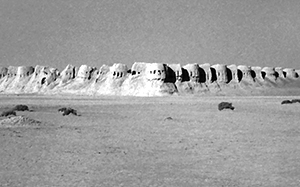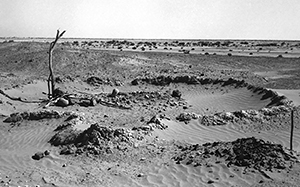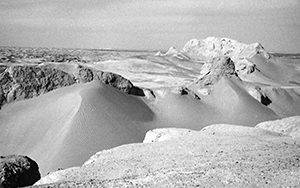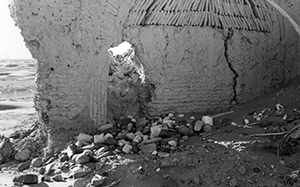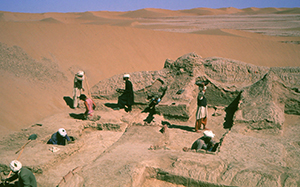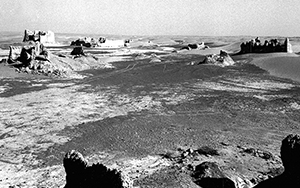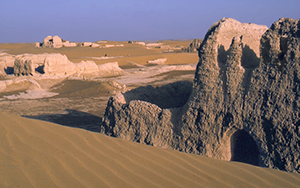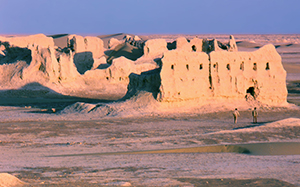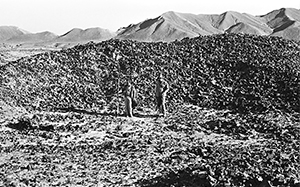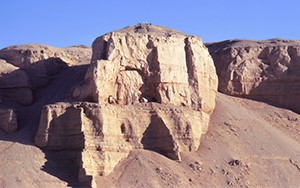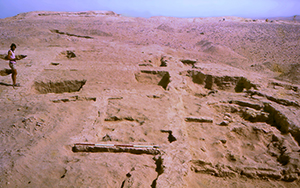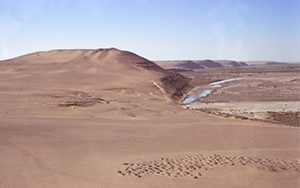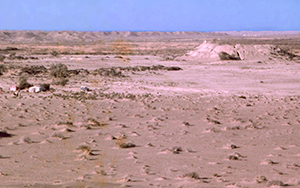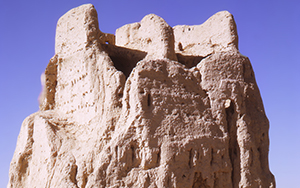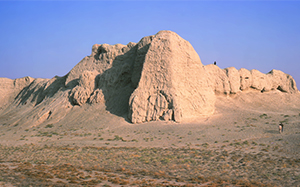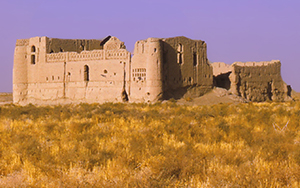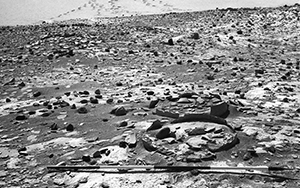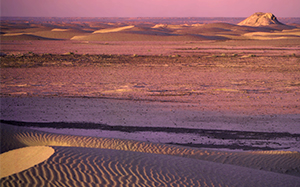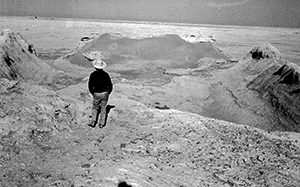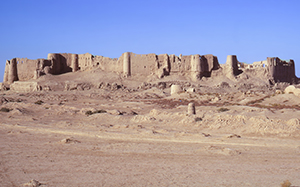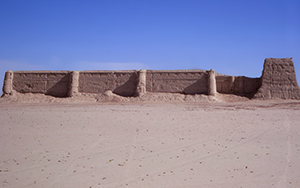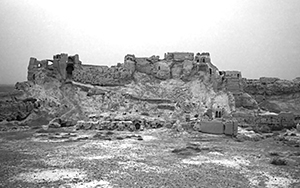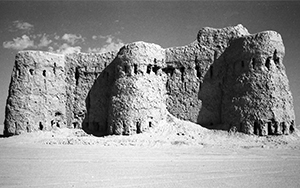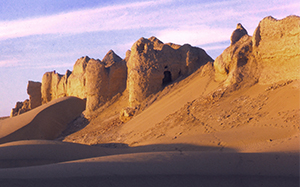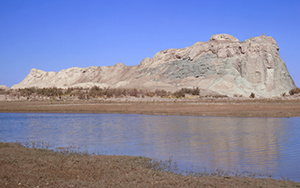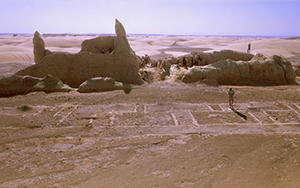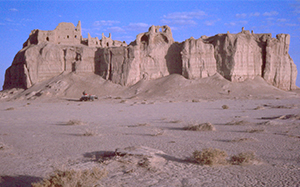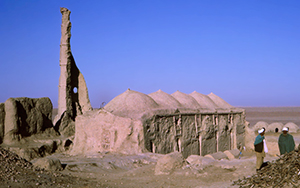Index of Key Sites
Chehel Burj
The site is an extensive complex of at least five large buildings. Though the standing buildings probably date to Ghaznavid times in the 11th century, ceramic evidence suggests they were first built in the early…
Chehel Burj
The site is an extensive complex of at least five large buildings. Though the standing buildings probably date to Ghaznavid times in the 11th century, ceramic evidence suggests they were first built in the early…
Dam
This is a Bronze Age site located on elevated ground next to the channel of the Shela Rud, the dry river bed linking the Hamun Lakes with the Gaud-i Zirreh, but which may have had…
Dam
This is a Bronze Age site located on elevated ground next to the channel of the Shela Rud, the dry river bed linking the Hamun Lakes with the Gaud-i Zirreh, but which may have had…
Dam-i Malik Khan
This badly eroded but very large, walled fortress, 320 x 100 m in size, is located just north of Qala-i Fath on the right bank of the Helmand River. It was placed overlooking the gap…
Dam-i Malik Khan
This badly eroded but very large, walled fortress, 320 x 100 m in size, is located just north of Qala-i Fath on the right bank of the Helmand River. It was placed overlooking the gap…
Godar-i Shah
Atop a conical mound 5 m in height along the Shela Rud are the remains of a mudbrick mausoleum for a recent imam. The site was visited by British explorers in the late 19th century…
Godar-i Shah
Atop a conical mound 5 m in height along the Shela Rud are the remains of a mudbrick mausoleum for a recent imam. The site was visited by British explorers in the late 19th century…
House 139
This large agricultural estate is located on the Sar-o-Tar Plain just south of Shahr-i Gholghola. We mapped the site in 1973 and partially excavated the badly eroded building in 1974. House 139 consisted of a…
House 139
This large agricultural estate is located on the Sar-o-Tar Plain just south of Shahr-i Gholghola. We mapped the site in 1973 and partially excavated the badly eroded building in 1974. House 139 consisted of a…
Houses 183
This cluster of five elite Timurid period estates stretches along an east-west canal in Sar-o-Tar just south of Shahr-i Gholghola. Each was built in typical 15th century CE style around a courtyard. In 1974 four…
Houses 183
This cluster of five elite Timurid period estates stretches along an east-west canal in Sar-o-Tar just south of Shahr-i Gholghola. Each was built in typical 15th century CE style around a courtyard. In 1974 four…
Houses 210
This is a cluster of houses, gardens, mausoleums, and other structures from the Timurid Period covering 1 km square in the western part of Sar-o-Tar. House 218 is the most elaborate of the buildings, a…
Houses 210
This is a cluster of houses, gardens, mausoleums, and other structures from the Timurid Period covering 1 km square in the western part of Sar-o-Tar. House 218 is the most elaborate of the buildings, a…
Houses 338
This is a cluster of structures that extends from southeast to northwest along a stretch of over 2 km in the Sar-o-Tar dunes. Dating from the Timurid period, it has the features of a full…
Houses 338
This is a cluster of structures that extends from southeast to northwest along a stretch of over 2 km in the Sar-o-Tar dunes. Dating from the Timurid period, it has the features of a full…
Jali Robat
The modern village sits in the hills at the border between Afghanistan and Pakistan at the foot of Koh-i Malik Siah mountain. Next to the village is an extensive field of copper slag, byproducts from…
Jali Robat
The modern village sits in the hills at the border between Afghanistan and Pakistan at the foot of Koh-i Malik Siah mountain. Next to the village is an extensive field of copper slag, byproducts from…
Khane Gauhar
Fragmentary remains of a Buddhist shrine overlook the Helmand Valley near the modern town of Darwishan. The shrine includes a mudbrick stupa 11 m in diameter and still standing over 2 m high, filled with…
Khane Gauhar
Fragmentary remains of a Buddhist shrine overlook the Helmand Valley near the modern town of Darwishan. The shrine includes a mudbrick stupa 11 m in diameter and still standing over 2 m high, filled with…
Khwaja Ali Sehyaka/Sehyak
A Mesopotamian-style temple and an accompanying compound for occupation and storage sat on a low bluff south of the Helmand Valley near Daishu. Surveyed in 1971, we noted Greek-style architectural fragments and fine red pottery.…
Khwaja Ali Sehyaka/Sehyak
A Mesopotamian-style temple and an accompanying compound for occupation and storage sat on a low bluff south of the Helmand Valley near Daishu. Surveyed in 1971, we noted Greek-style architectural fragments and fine red pottery.…
Khwaja Kanur
A large hill on the east side of the Helmand River at its juncture with the Arghandab River contains this site. The hilltop consists of a ridge running 200 m east to west. A recent…
Khwaja Kanur
A large hill on the east side of the Helmand River at its juncture with the Arghandab River contains this site. The hilltop consists of a ridge running 200 m east to west. A recent…
Lat Qala
This is a prominent mound 14 m high and 75 m in diameter at the southern edge of the Helmand River Valley in the Rudbar area. It contains the clearest stratigraphic sequence we were able to establish…
Lat Qala
This is a prominent mound 14 m high and 75 m in diameter at the southern edge of the Helmand River Valley in the Rudbar area. It contains the clearest stratigraphic sequence we were able to establish…
Malakhan Plain Sites
The Malakhan Plain is on the inside of the curve of the Helmand River where it shifts from flowing south to west, covering an extent of about 10 km in length and 5 km in…
Malakhan Plain Sites
The Malakhan Plain is on the inside of the curve of the Helmand River where it shifts from flowing south to west, covering an extent of about 10 km in length and 5 km in…
Mukhtar
A large fortified site in the area of Lashkar Gah, Mukhtar likely contained a Hellenistic temple. We base this on the numerous column bases and drums, Ionian column volutes, and other Greek-style architectural decorations, figurines,…
Mukhtar
A large fortified site in the area of Lashkar Gah, Mukhtar likely contained a Hellenistic temple. We base this on the numerous column bases and drums, Ionian column volutes, and other Greek-style architectural decorations, figurines,…
Palangi
A large post-Timurid estate with highly decorated walls and a windmill still stands prominently at the edge of the modern village of Hauz. The names of the estate and the village are often conflated. Its…
Palangi
A large post-Timurid estate with highly decorated walls and a windmill still stands prominently at the edge of the modern village of Hauz. The names of the estate and the village are often conflated. Its…
Plain of Jars
The area to the south and west of Shahr-i Gholghola contained a dozen sites that featured large storage jars set into the ground with a scatter of ceramics from Parthian and Sasanian times around them.…
Plain of Jars
The area to the south and west of Shahr-i Gholghola contained a dozen sites that featured large storage jars set into the ground with a scatter of ceramics from Parthian and Sasanian times around them.…
Qala 169
A large Sar-o-Tar fortified mound 50 x 80 m in size and 15 m high is surrounded by a lower circular walled compound to the southeast 140 x 80 m in dimension. It is where…
Qala 169
A large Sar-o-Tar fortified mound 50 x 80 m in size and 15 m high is surrounded by a lower circular walled compound to the southeast 140 x 80 m in dimension. It is where…
Qala 350A
Of the 20 sites we identified as dating to the Early Iron Age, Qala 350A is by far the largest and most impressive. Most of the sites of that date are built on a large…
Qala 350A
Of the 20 sites we identified as dating to the Early Iron Age, Qala 350A is by far the largest and most impressive. Most of the sites of that date are built on a large…
Qala-i Fath
This prominent site along the Helmand River was built in the 15th century CE and abandoned in the 18th century according to historical records. It was visited by numerous previous researchers so was not systematically…
Qala-i Fath
This prominent site along the Helmand River was built in the 15th century CE and abandoned in the 18th century according to historical records. It was visited by numerous previous researchers so was not systematically…
Qala-i Nau
This imposing fortress, also known as Chakansurak and Noken Qala, is at the northern edge of Sar-o-Tar outside the sand dune fields. It was extensively documented by previous researchers so warranted only a brief visit…
Qala-i Nau
This imposing fortress, also known as Chakansurak and Noken Qala, is at the northern edge of Sar-o-Tar outside the sand dune fields. It was extensively documented by previous researchers so warranted only a brief visit…
Qala-i Sirak
This is one of the largest archaeological sites in the Helmand Valley, a massive fortress sitting on the right bank of the Helmand River near the modern town of Malakhan. Based upon pottery found in…
Qala-i Sirak
This is one of the largest archaeological sites in the Helmand Valley, a massive fortress sitting on the right bank of the Helmand River near the modern town of Malakhan. Based upon pottery found in…
Qala-i Surkh North
Also called Sohren Qala, it is a very well preserved two-story fortress at the northeastern end of the Sar-o-Tar Plain leading to the main trade route to the east through the Dasht-i Margo desert. Approximately…
Qala-i Surkh North
Also called Sohren Qala, it is a very well preserved two-story fortress at the northeastern end of the Sar-o-Tar Plain leading to the main trade route to the east through the Dasht-i Margo desert. Approximately…
Shahr-i Gholghola
Probably the Islamic fortress city of Taq mentioned in numerous medieval texts, Shahr-i Gholghola is the largest single site in our project area, with standing walls over 1 km in length and over 10 m…
Shahr-i Gholghola
Probably the Islamic fortress city of Taq mentioned in numerous medieval texts, Shahr-i Gholghola is the largest single site in our project area, with standing walls over 1 km in length and over 10 m…
Sna Qala
Located atop an outcropping of green volcanic stone on the north bank of the Helmand River, the site features a Sasanian fire temple on its summit across the river from the largest natural feature in…
Sna Qala
Located atop an outcropping of green volcanic stone on the north bank of the Helmand River, the site features a Sasanian fire temple on its summit across the river from the largest natural feature in…
Temple 215
A large Zoroastrian fire temple with fine, heavily plastered walls and flooring was found at the south edge of the Sar-o-Tar sand dunes on a low rise in the flood plain. Excavated in 1973, coins…
Temple 215
A large Zoroastrian fire temple with fine, heavily plastered walls and flooring was found at the south edge of the Sar-o-Tar sand dunes on a low rise in the flood plain. Excavated in 1973, coins…
Trakhun
Trakhun is one of the best known and most visible sites in Sistan. A high-walled fortress situated atop a 30 m high triangular rock formation over 100 m on each side in the center of…
Trakhun
Trakhun is one of the best known and most visible sites in Sistan. A high-walled fortress situated atop a 30 m high triangular rock formation over 100 m on each side in the center of…
Ziyarat-i Amiran Sahib
The shrine dedicated to Amiran, a heroic figure who helped convert the region to Islam, is still in use today. Located at the northern edge of Sar-o-Tar, it consists of the purported burial hall of…
Ziyarat-i Amiran Sahib
The shrine dedicated to Amiran, a heroic figure who helped convert the region to Islam, is still in use today. Located at the northern edge of Sar-o-Tar, it consists of the purported burial hall of…



